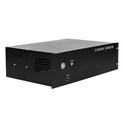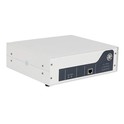Ultrasonic technology has made significant inroads into various industries, offering innovative solutions to long - standing problems. As a supplier of ultrasonic rings, I often get asked about the potential applications of these devices, especially in the construction industry. In this blog post, I'll explore whether an ultrasonic ring can be used for construction applications.
Understanding Ultrasonic Rings
Before delving into construction applications, it's essential to understand what an ultrasonic ring is. An ultrasonic ring is a device that generates ultrasonic waves. These waves are sound waves with frequencies higher than the upper audible limit of human hearing, typically above 20 kHz. Ultrasonic rings work by converting electrical energy into mechanical vibrations, which then produce ultrasonic waves.
We offer two popular models: the ResoRing - 25 Ultrasonic Ring and the ResoRing - 30 Ultrasonic Ring. These rings are designed with high - quality materials and advanced technology to ensure efficient and reliable performance.
Potential Construction Applications of Ultrasonic Rings
Concrete Mixing and Compaction
One of the most promising applications of ultrasonic rings in construction is in concrete mixing and compaction. Ultrasonic waves can be used to improve the homogeneity of concrete mixtures. When an ultrasonic ring is placed in a concrete mixer, the ultrasonic vibrations break down agglomerates of cement particles, allowing for better dispersion of water and additives. This results in a more uniform concrete mix with improved workability.


In terms of compaction, ultrasonic waves can help reduce the air voids in concrete. Air voids in concrete can weaken its structure and reduce its durability. By applying ultrasonic vibrations during the pouring and setting process, the air bubbles are forced to rise to the surface, resulting in a denser and stronger concrete structure. Some studies have shown that ultrasonic - assisted compaction can increase the compressive strength of concrete by up to 20%.
Nondestructive Testing
Another important application is nondestructive testing (NDT) of construction materials. Ultrasonic waves can penetrate deep into materials such as concrete, steel, and wood, and detect internal flaws or defects. When an ultrasonic ring is used in NDT, it sends out ultrasonic pulses into the material. These pulses are reflected back when they encounter a defect, such as a crack or a void. By analyzing the time it takes for the pulses to return and the characteristics of the reflected waves, engineers can determine the location, size, and nature of the defect.
This is particularly useful in large - scale construction projects, where early detection of defects can prevent costly repairs and ensure the safety of the structure. For example, in a high - rise building, ultrasonic NDT can be used to check the integrity of concrete columns and beams during construction and throughout the building's lifespan.
Soil Stabilization
Soil stabilization is a crucial step in many construction projects, especially in areas with poor soil conditions. Ultrasonic rings can be used to improve the properties of soil. Ultrasonic vibrations can break down soil particles and rearrange them in a more compact and stable configuration. This can increase the bearing capacity of the soil and reduce settlement.
In addition, ultrasonic waves can be used to enhance the effectiveness of soil - stabilizing agents. When an ultrasonic ring is used in combination with chemical stabilizers, the ultrasonic vibrations help in better dispersion of the stabilizer in the soil, resulting in more efficient soil stabilization.
Cleaning of Construction Equipment
Construction equipment such as excavators, bulldozers, and concrete pumps often get dirty and clogged with mud, concrete, and other debris. Ultrasonic rings can be used to clean these equipment parts effectively. The high - frequency ultrasonic waves create cavitation bubbles in a cleaning solution. These bubbles implode near the surface of the equipment parts, creating a powerful scrubbing action that removes dirt and contaminants without damaging the parts.
This is a more environmentally friendly and cost - effective alternative to traditional cleaning methods, which often involve the use of harsh chemicals and high - pressure water jets.
Challenges and Limitations
High Initial Investment
One of the main challenges of using ultrasonic rings in construction is the high initial investment. The cost of purchasing and installing ultrasonic rings, along with the necessary control systems, can be significant. For small - scale construction companies, this may be a deterrent. However, in the long run, the benefits in terms of improved quality, reduced maintenance costs, and increased productivity may outweigh the initial investment.
Technical Expertise Required
Operating ultrasonic rings requires a certain level of technical expertise. Construction workers need to be trained on how to use the equipment properly, including setting the appropriate ultrasonic frequencies and power levels. This may require additional training programs and resources, which can be time - consuming and costly.
Compatibility with Existing Construction Processes
Integrating ultrasonic rings into existing construction processes can be challenging. Construction sites are often chaotic environments, and it may be difficult to find a suitable location to install the ultrasonic rings without disrupting the workflow. In addition, the ultrasonic equipment needs to be compatible with other construction machinery and tools.
Future Outlook
Despite the challenges, the future of ultrasonic rings in construction looks promising. As the technology continues to develop, the cost of ultrasonic rings is likely to decrease, making them more accessible to a wider range of construction companies. In addition, research is ongoing to improve the performance and efficiency of ultrasonic - based construction applications.
For example, new ultrasonic ring designs are being developed that are more compact, energy - efficient, and easier to integrate into existing construction processes. There is also a growing interest in using ultrasonic rings in combination with other emerging technologies such as artificial intelligence and the Internet of Things (IoT) to create smart construction systems.
Conclusion
In conclusion, ultrasonic rings have significant potential for use in construction applications. From concrete mixing and compaction to nondestructive testing and soil stabilization, these devices offer innovative solutions to some of the most pressing problems in the construction industry. However, there are still challenges that need to be overcome, such as high initial investment, technical expertise requirements, and compatibility issues.
As a supplier of ultrasonic rings, I am committed to working with construction companies to explore the full potential of this technology. If you are interested in learning more about how our ultrasonic rings can be used in your construction projects or would like to discuss a potential purchase, please feel free to contact us. We are ready to provide you with detailed product information and technical support to help you make an informed decision.
References
- Smith, J. (2018). "Ultrasonic Applications in Construction: A Review." Journal of Construction Engineering and Management, 144(11), 04018072.
- Johnson, A. (2019). "Improving Concrete Quality with Ultrasonic Technology." Concrete International, 41(5), 45 - 50.
- Brown, C. (2020). "Nondestructive Testing of Construction Materials Using Ultrasonic Waves." Journal of Nondestructive Evaluation, 39(2), 1 - 15.





